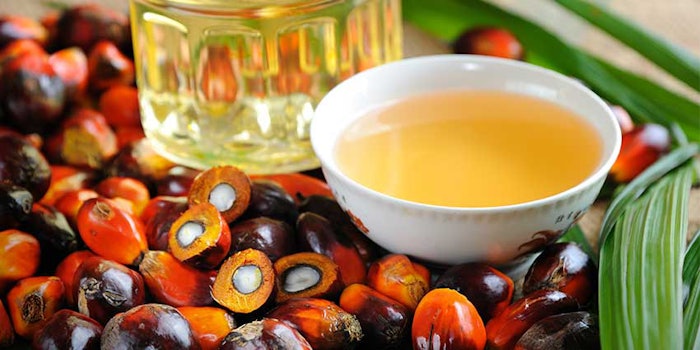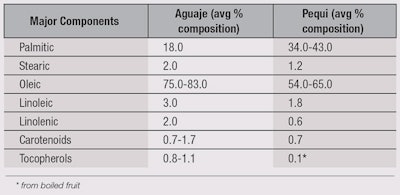
The vast Amazon territory includes 30 million species of plants, a limited number of which have been studied extensively or linked to traditional knowledge. Local use of some of these plants in the food supply chain or traditional medicine has been associated mainly to their organoleptic properties or healing capabilities, respectively.1 Introducing them to the larger market is challenging, as it poses questions of profitability, but also of sustainability given the wild nature of most of them. However, some of these plants have already found an entry thanks to their known traditional benefits, positioning them as “super plants.”
The food and nutrition supply chain is often their first entry to market, but other applications for these plants are increasing, especially in personal care and cosmetics. Among the different sources for naturals in cosmetics, palm trees from the forest or Brazilian Cerrado are quite popular. Their fruits are used by the locals for cooking or traditional medicine. In particular, aguaje and pequi palm oils and fruit have been used in traditional medicine, mostly for anti-inflammatory and healing benefits.2 The present article profiles these palm oils in terms of their sustainability, chemistry and application.
Sustainability and Manufacture
Mauritia flexuosa—i.e., the aguaje or buriti palm, is one of the most abundant South American palm trees, and its fruit is one of the most important in the lower Amazon Rainforest urban market. Although it is not processed on an industrial level, the fruit provides income for a significant sector of the population, particularly women. In Iquitos, Peru, it is estimated that some 5,000 families make their living in relation to its commercialization. The monthly demand for aguaje fruit is approximately 1,500 tons, or 50 tons per day.
In its adult stage, the aguaje palm can grow up to 35 m in height and 50 cm in diameter. It produces hundreds of oval, red-shaped fruits approximately 6 cm long. To reach the fruits, the tree is either climbed or cut. While cutting the trees risks their sustainability, climbing them is time-consuming and laborious; however, the dwarf aguaje variety has recently been identified, which is shorter yet bears the same amount of fruit. This palm does not require cutting to reach the fruits, making it more sustainable. Moreover, the dwarf palm develops faster than the common aguaje palm, providing fruits earlier in the year.
The fruit of Caryocar coriaceum or brasiliense, or the pequi tree, is used in traditional regional dishes. Native to the Cerrado savanna, the tree serves a conservation role, as this environment is threatened by the expansion of eucalyptus and soy monocultures. Cooperatives have recognized the need to protect the pequi tree from being cut, but also its importance to the livelihoods of local communities. These cooperatives have established the Pró-Pequi Law, which regulates pequi extraction and protects the tree from being cut. With regulatory measures in place, the pequi tree is now helping to protect natural areas, as it generates income for local communities.3
Chemistry and Applications
Pequi and aguaje fruits are rich in carotenoids, and vitamins A and E.4-6 Vitamin A is particularly beneficial for the skin, eyes, sinus and throat, and protects against bronchial infections. These fruit oils can be either cold-pressed or boiled to separate the oil. Cold pressing is helpful to maintain the unsaponifiable fractions rich in active molecules such as vitamins, polyphenols, etc. The oils have a distinctive orange color, and also contain high levels of monounsaturated fatty acids, especially oleic acid (see Table 1). They have found application in traditional medicine and, more recently, as nutritional supplements for specific applications. For example, pequi oil has shown anti-inflammatory and wound healing capacities,7-9 and it is being used by runners as a nutritional supplement to reduce oxidative stress and blood pressure, and to improve healing.10, 11 Aguaje oil has been used for its antimicrobial, anti-inflammatory and antioxidant properties,12, 13 and a role in photo-protection has been suggested.14
While pequi and aguaje oils have successfully been developed in the foods market, recent studies indicate their use in cosmetic formulations as antibacterial, antioxidant and moisturizing ingredients.15, 16 Their antioxidant, vitamin E and polyphenol content also suggest a role in photoprotection.14, 17 Indeed, studies have shown they absorb in the UV spectra, although their impact as SPF boosters is not relevant at levels up to 10%.17 It would perhaps be more interesting to investigate their role as general antioxidants and healers, as suggested by preliminary studies.3, 8, 12
Formulation Guidelines
These oils can be easily formulated into oil-based products or emulsions. Being rich in vitamin A and carotenoids, their concentration in the finished product would require optimization based on the skin target. Suggested use levels are 0.1-5%, and high concentrations can affect the color of the finished product. The oils act as natural solubilizers and carriers for vitamins A and E, and carotenoids. They also help to maintain the stability of vitamins and carotenoids by protecting them from direct exposure to air. Moreover, their high percentage of oleic acid enables them to penetrate the skin barrier, allowing lipo-soluble carotenoids and vitamins to penetrate more easily into the deeper layers of skin.
Conclusions
Aguaje and pequi oils are sustainable if methods of harvesting and cultivating them are implemented so as not to deplete the palms. Valorization of the oils in the cosmetic industry can create added value and motivate local populations and farmers not to cut the trees down. It is important for local biodiversity to be maintained and sustainably used to preserve local species to benefit ecosystems of the future. Although the oils are currently sourced and available, existing suppliers will need to increase access to commercially viable supplies to guarantee a sustainable business.
Such sources of highly concentrated vitamins and actives from so-called “super fruits” are not only alternatives to synthetic or purified sources, they also provide added benefits and synergies. This is due to the variety of molecules present within the same fruit—true phyto-complexes with increased stability and efficacy.
References
- MF Agra, PF Freitas and JM Barbosa-Filho, Synopsis of the plants known as medicinal and poisonous in Northeast of Brazil, Rev Bras Farmacog 17(1) 114–40 (2007)
- MJ Balick, The use of palms by the Apinayé and Guajajara Indians of northeastern, Brazil Adv Econ Bot 6 65–90 (1988)
- J Ribamar Sousa Júnior, U Paulino Albuquerque and N Peroni, Traditional knowledge and management of Caryocar coriaceum Wittm. (pequi) in the Brazilian savanna, Northeastern Brazil Econ Bot 67(3) 225–33 (2013)
- BA Ferreira et al, Comparative properties of Amazonian oils obtained by different extraction methods, Molecules 16(7) 5875–85 (2011)
- LF de Franç, G Reber, MAM Meireles, NT Machado and G Brunner, Supercritical extraction of carotenoids and lipids from buriti (Mauritia flexuosa), a fruit from the Amazon region, J Supercritical Fluids 14(3) 247–56 (1999)
- AM da Cruz Rodrigues, S Darnet and LH Meller da Silva, Fatty acid profiles and tocopherol contents of buriti (Mauritia flexuosa), patawa (Oenocarpus bataua), tucuma (Astrocaryum vulgare), mari (Poraqueiba paraensis) and inaja (Maximiliana maripa) Fruits, J Braz Chem Soc 21(10) 2000–4 (2010)
- RA Saraiva et al, Topical anti-inflammatory effect of Caryocar coriaceum Wittm. (Caryocaraceae) fruit pulp fixed oil on mice ear edema induced by different irritant agents, J Ethnopharmacol 136(3) 504–10 (2011)
- ML de Oliveira et al, In vivo topical anti-inflammatory and wound healing activities of the fixed oil of Caryocar coriaceum Wittm seeds, J Ethnopharmacol 129(2) 214–9 (2010)
- AL Miranda-Vilela, IS Resck and CK Grisolia, Antigenotoxic activity and antioxidant properties of organic and aqueous extracts of pequi fruit (Caryocar brasiliense Camb.) pulp, Genet Mol Biol 31(4) 956–63 (2008)
- AL Miranda-Vilela, LC Pereira, CA Gonçalves and CK Grisolia, Pequi fruit (Caryocar brasiliense Camb.) pulp oil reduces exercise-induced inflammatory markers and blood pressure of male and female runners, Nutr Res 29(12) 850–8 (2009)
- AL Miranda-Vilela et al, Dietary carotenoid-rich pequi oil reduces plasma lipid peroxidation and DNA damage in runners and evidence for an association with MnSOD genetic variant-Val9Ala, Genet Mol Res 8(4) 1481–95 (2009)
- J Soares Batista et al, Atividade antibacteriana e cicatrizante do óleo de buriti Mauritia flexuosa L. (Antibacterial and healing activities of buriti oil Mauritia flexuosa L.), Ciência Rural 42(1) 136–41 (2012)
- JG Mariath, MC Lima and LM Santos, Vitamin A activity of buriti (Mauritia vinifera Mart) and its effectiveness in the treatment and prevention of xerophthalmia, Am J Clin Nutr 49(5) 849–53 (1989)
- CF Zanatta, M Mitjans, V Urgatondo, PA Rocha-Filho and MP Vinardell, Photoprotective potential of emulsions formulated with buriti oil (Mauritia flexuosa) against UV irradiation on keratinocytes and fibroblasts cell lines, Food Chem Toxicol 48(1) 70–5 (2010)
- W Costa Silva Faria, GA de Brito Damasceno and M Ferrari, Moisturizing effect of a cosmetic formulation containing pequi oil (Caryocar brasiliense) from the Brazilian cerrado biome, Brazilian J Pharma Sci 50(1) 131–36 (2014)
- LF Amaral, P Moriel, MA Foglio and PG Mazzola, Caryocar brasiliense supercritical CO2 extract possesses antimicrobial and antioxidant properties useful for personal care products, BMC Complement Altern Med 14 73(2014)
- HC Polonini et al, Amazon native flora oils: In vitro photoprotective activity and major fatty acids constituents, Rev Bras Farm 93 (1) 102–08 (2012)











